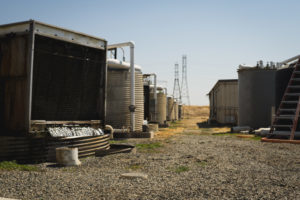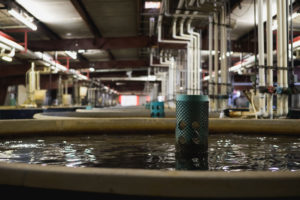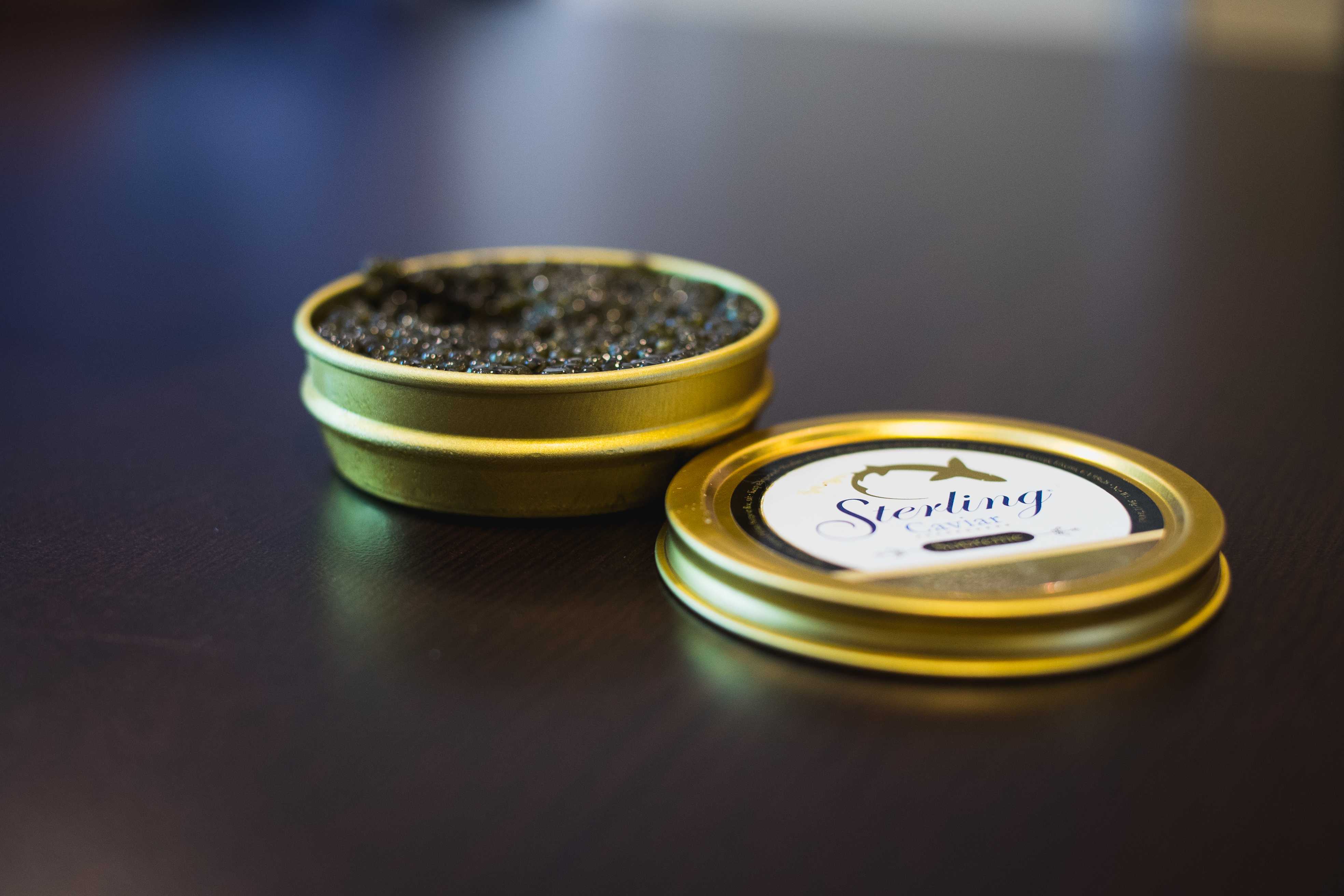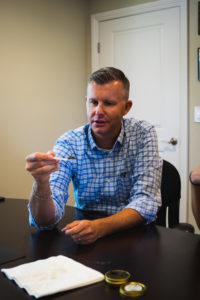Caviar, a rich and historically perceived decadent garnish, has become a pivotal player in the sustainable aquaculture game. This is in large thanks to Sterling Caviar, whose caviar products are changing how caviar is perceived by the public and are serving as examples of strategic sustainability. I had the opportunity to spend the day at Sterling Caviar’s main farm to talk with the President, Camron King, and meet the stars of the day—the white sturgeon.
Sterling Caviar’s main farm sits to the side of a winding desolate road in Elverta, CA. The entrance and sign were so unobtrusive, I initially drove past the gate and missed the farm entirely. Once I double-backed, I had to get pass the security gates to enter. The farm included a few non-descript buildings and mostly dirt or gravel paths. But even with its humble and simple exterior, Sterling Caviar has always been a trend setter.
Initially started as a farm to raise fish for meat consumption, Sterling Caviar soon became the first aquaculture farm for sustainable sturgeon in the world. All of the sturgeon are spawned, grown, nurtured, and then harvested at one of the farms in a tightly closed sustainable loop, always with an eye for doing right by the environment.
Sustainability is not just a hard and fast solution. It’s not like we cross into the end zone and we’re done. We need to be continually progressing because it’s the right thing to do.
Sustainability for the company is a value-added proposition. Their caviar’s quality stands for itself and the company doesn’t need to engage in processes that account for environmental impact or think beyond the harvest profit. However, the continuing commitment by leadership to engage in sustainable processes has allowed the company to be champions and above the rest.
As Camron stated, “Sustainability is not just a hard and fast solution. It’s not like we cross into the end zone and we’re done. We need to be continually progressing because it’s the right thing to do.”
The company’s processes include a holistic system where the sturgeon are always given the greatest respect and where the environment around the farm is taken care of. The farm pumps water out of the aquaphor below and uses that water to raise the sturgeon in tanks. As the fish grow from a size no bigger than a finger to adulthood, they are transferred to different and larger tanks to account for comfort for the fish. The farm tries to replicate native environmental factors as much as possible for the fish.
“Everything we do is deliberate and hands on, from where we spawn by hand to where we raise the fish. We do what we can to make the fish healthy and happy.” The company is also careful to always minimize waste. Camron was quick to boast that the farm only uses 2 dumpsters and 1 recycling bin. The farm is careful about creating a thriving ecosystem and nurturing symbiotic relationships.
All water used is recycled and cleaned through five uses before it’s put through a biofiltration system that cleans it one last time, after which it’s pumped back out to the adjacent rice farms for use. Camron proudly noted that the water pumped back out is generally cleaner than what they had originally pumped in. 
In the Photo: A row of biofiltration tanks used to properly clean water before recycled use. Photo Credit: Alexander Dou
Caviar is defined by the United Nation’s Food and Agriculture Organization as roe from sturgeon, and only sturgeon. All of Sterling Caviar’s fish are white sturgeon because this species is native to that area, the Sacramento Delta. The company doesn’t believe in “moving native species out of their environment just because you can.”
The entire growing period can last as long as 7-10 years. The sturgeon initially start in small tanks for a year and as they start getting bigger, oxygen is introduced to the water so the fish aren’t stressed. The food is made of plant protein and every tank has a cooling tower with substrates that collects any bio matter. Constant monitoring and collection of data also occurs to ensure that the fish are kept in the right cold-water temperatures, and to allow the company to expand on their sustainability efforts through data analysis.
After a few years of growth, the team uses a non-invasive and gentle ultrasound to quickly scan the fish for gender and separate the females from males, to be used for harvesting eggs. The males are sent to another facility for meat harvesting and the females continue to grow. At 7-10 years old, the sturgeon have grown and are up to 6 feet in length, can be 75-125 pounds, and are ready to be harvested for their roe. 
In the Photo: A view of the massive tanks, spanning 18-20 feet deep, used to house sturgeon. Photo Credit: Alexander Dou
In the caviar industry, there are several methods for harvesting. You can aggressively massage the eggs out, forcing them out by hand, or do a cesarean section which allows for the fish to go through another harvest. However, Sterling Caviar found that most of the traditional methods ended up being incredibly painful and stressful for the fish, sometimes resulting in fish dying from the harvesting. They opted instead for a quick death for the fish and harvesting after death, working with the local Humane Society to make sure that this process is genuinely painless.
The entire fish has its purpose and we respect our fish.
To ensure that the process is fully sustainable, all parts of the fish are sent to different vendors for consumption or use. “The entire fish has its purpose and we respect our fish.”
We took some time during the tour to visit the sturgeon gently swimming around the tanks. Looking into the tanks, Camron fondly said, “These fish have personalities.” By having a continued understanding of the fish, people like Camron continue to stand by methods that respect the fish.
Because of the historically narrowed view of caviar, for Camron and Sterling Caviar, accessibility is as important as sustainability. Long seen as an opulent product eaten by the affluent, Camron believes that the solution to accessing caviar as a sustainable protein source lies with millennials.
As Camron noted, “Caviar is a space where a lot of people don’t really know what it is. We need a lot more millennials in the conversation. Can we as an industry grow and evolve? Millennials,” he further notes, “care about where their food comes from and how it’s produced, which allows brands like Sterling Caviar to stay relevant.”
Related Articles:
![]() HOG ISLAND OYSTER COMPANY, A LEADER IN SUSTAINABLE AQUACULTURE
HOG ISLAND OYSTER COMPANY, A LEADER IN SUSTAINABLE AQUACULTURE
by Michelle Wu
![]() WILDER & HARRIER: INNOVATIVE AND SUSTAINABLE PET FOOD
WILDER & HARRIER: INNOVATIVE AND SUSTAINABLE PET FOOD
by Mohamed Akef
![]() AGRIFOOD IN ITALY: HOW ANGA TACKLES THE SDGS
AGRIFOOD IN ITALY: HOW ANGA TACKLES THE SDGS
But the fight to stay relevant and be a powerful player in this industry can be a tough one. Sterling Caviar is currently the largest producer of caviar in North America, producing around 80% of all caviar, about 15 tons a year. However, they are up against behemoths like China who produce 70-80 metric tons a year.
And the rules of the game differ between the players. Sterling Caviar is held to the regulations set by the Food and Drug Administration, such as the banning of Borax as a preservative. All caviar is therefore salted instead, and this results in a slightly less firm texture than a Borax preserved egg. Because the same regulations do not apply in other countries, US producers find themselves up against companies who are producing more at a cheaper rate.
Camron noted, “I am happy to compete. But let’s compete on an even playing field.” He and Sterling Caviar are working with the FDA to ensure that domestic producers can thrive more on a competitive foundation.
Caviar is a complex and nuanced product that can and should be accessible to all. Camron is committed to working at every single segment and selling to restaurants, distributors, hotels, and even cruise lines. “We sell to anybody and everybody.”
That mantra comes with a need for education and awareness about the uses of caviar. Camron also believes that chefs and experimental uses of caviar will open the door to expanded consumption. Caviar doesn’t need to be eaten on a blini with creme fraiche. There are varied uses and eggs can vary in color, size and texture, all to lead to different tiers of flavor.
As our conversation that day came to a close, we ended with an impromptu caviar tasting. We ended up eating it directly or on some kettle chips he poured out into a bowl he found nearby. I was taught to place the caviar directly on my closed fist for a “bump of caviar,” so that the roe was warmed slightly by my body heat and my natural oils/salt added to the flavor profile.
 In the Photo: Camron King demonstrating a “bump of caviar”. Photo Credit: Alexander Dou
In the Photo: Camron King demonstrating a “bump of caviar”. Photo Credit: Alexander Dou
We ended up talking at length about caviar flavor and eating opportunities. The product felt very accessible and intimately close. What may be currently a value-added component, is a huge deciding factor for sustainability-aware customers to choose a brand like Sterling Caviar. And together, consumers and producers can continue down the sustainable aquaculture road.









